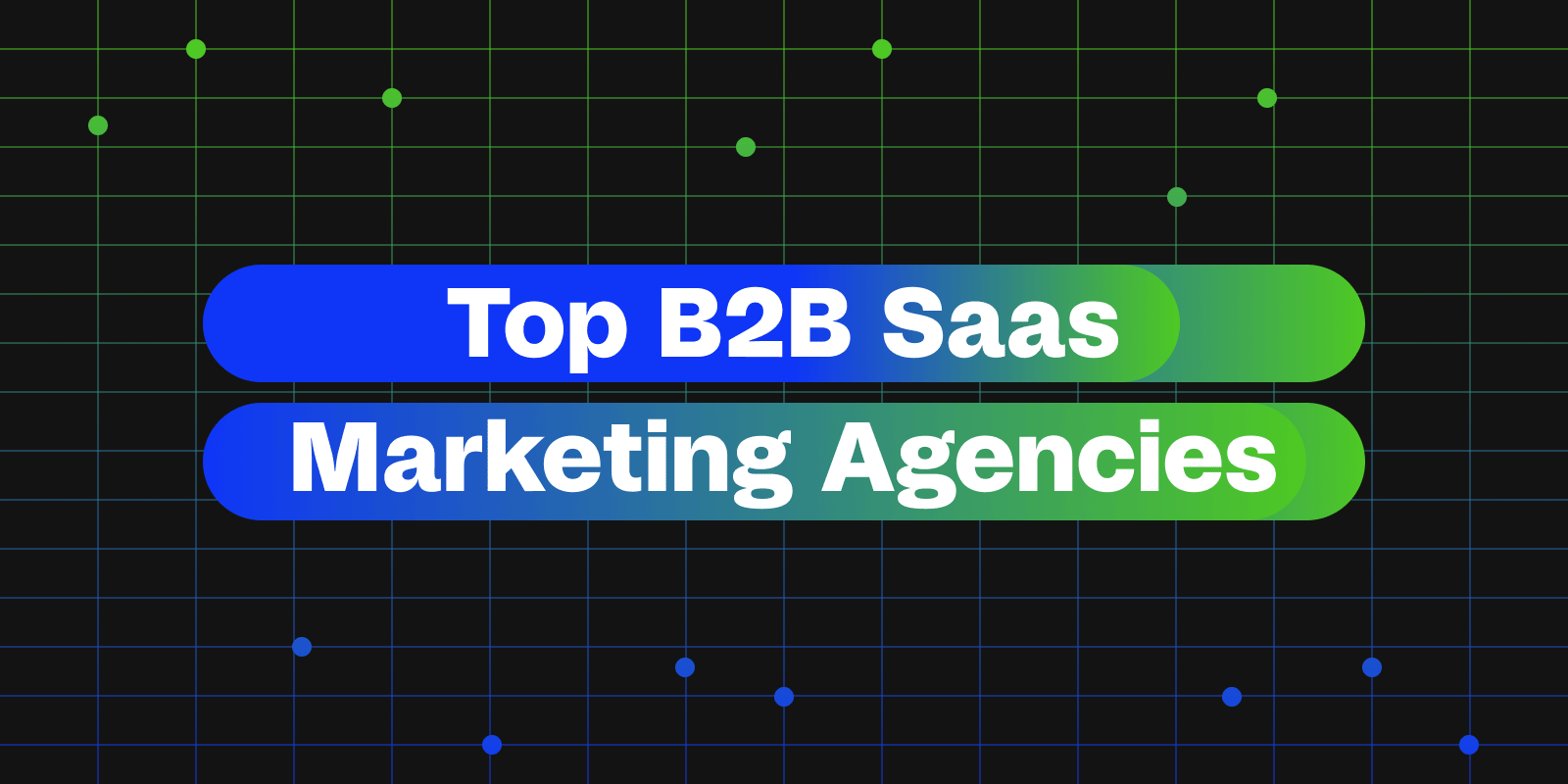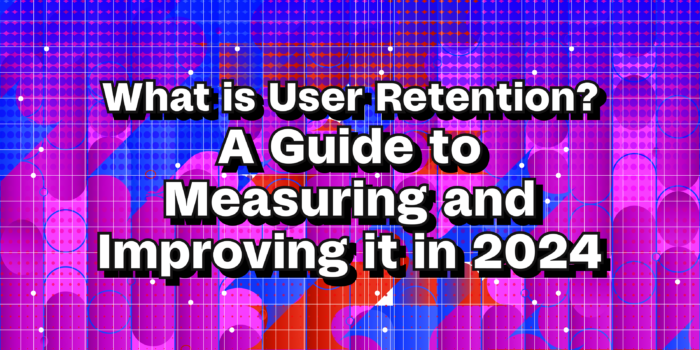While many see building growth strategies for B2C products and businesses as more simple than their B2B counterparts, the reality is that the paths and strategies are fairly similar — though not without their own nuances. In fact, with the growth of social media and brands placing a deeper focus on developing public personas, the two strategies have never been more similar than they are today and will likely continue to become more homogenous as the landscape continues to shift. This leaves the following as the largest barriers for those building a B2B SaaS growth strategy:
- Specialized demographics
- Difficult targeting
- Higher price points
- Specialized products
- Multi-step approval process
Ultimately, the usual suspsects of growth are in play with brands relying upon SEO (with a companion PPC strategy), content, sales reps, and email in order to both be discovered by users and drive them down the funnel. The nuance comes, as it tends to do, from the way in which these tools are used – and in this case, whom they are used for.
For B2B SaaS projects the unique challenge lies int he fact that while with B2C businesses the customer or end user is an individual who has a set budget and is typically the sole decision maker for making purchases, that isn’t necessarily true of B2B products. For B2B, the customer is not an indidivudal, but fractured to be an amalgam of those controlling and approving spending, those controlling and approving the discovery and decision making, and those who are the end user, with each of these touch points potentially influencing different stages of the process — which requires an understanding of not just the tools being implemented, but the target, their goals, and the solutions being provided.
For each of the traditional growth tools previously mentioned, we’ll explore both how they can be – and in some cases have been – implemented into your growth stacks, while outlining which persona they will be targeting within an organization, what stage of the loop that individual may be in, and the goal for that particular tactic. This will give both a comprehensive view of the possible iterations of a B2B SaaS strategy for growth, but the various ways in which these tactics can interplay & complement one another.
Determining cross-functional pain points
With B2B SaaS businesses, there are – as previously mentioned – likely a number of layers of approvals and validation that need to be cleared prior to adoption and conversion. What this means for strategies is that, there are additional considerations that need to be taken into consideration when addressing pain points in your strategy and making decisions as to who is being targeted with each of your tactics.
For example, if we were to build a strategy for a payroll software service the messaging would vary greatly depending on who is being targeted within an audience, what problems they are trying to solve, and what goals they are looking to achieve.
Let’s break down the pain points of each user:
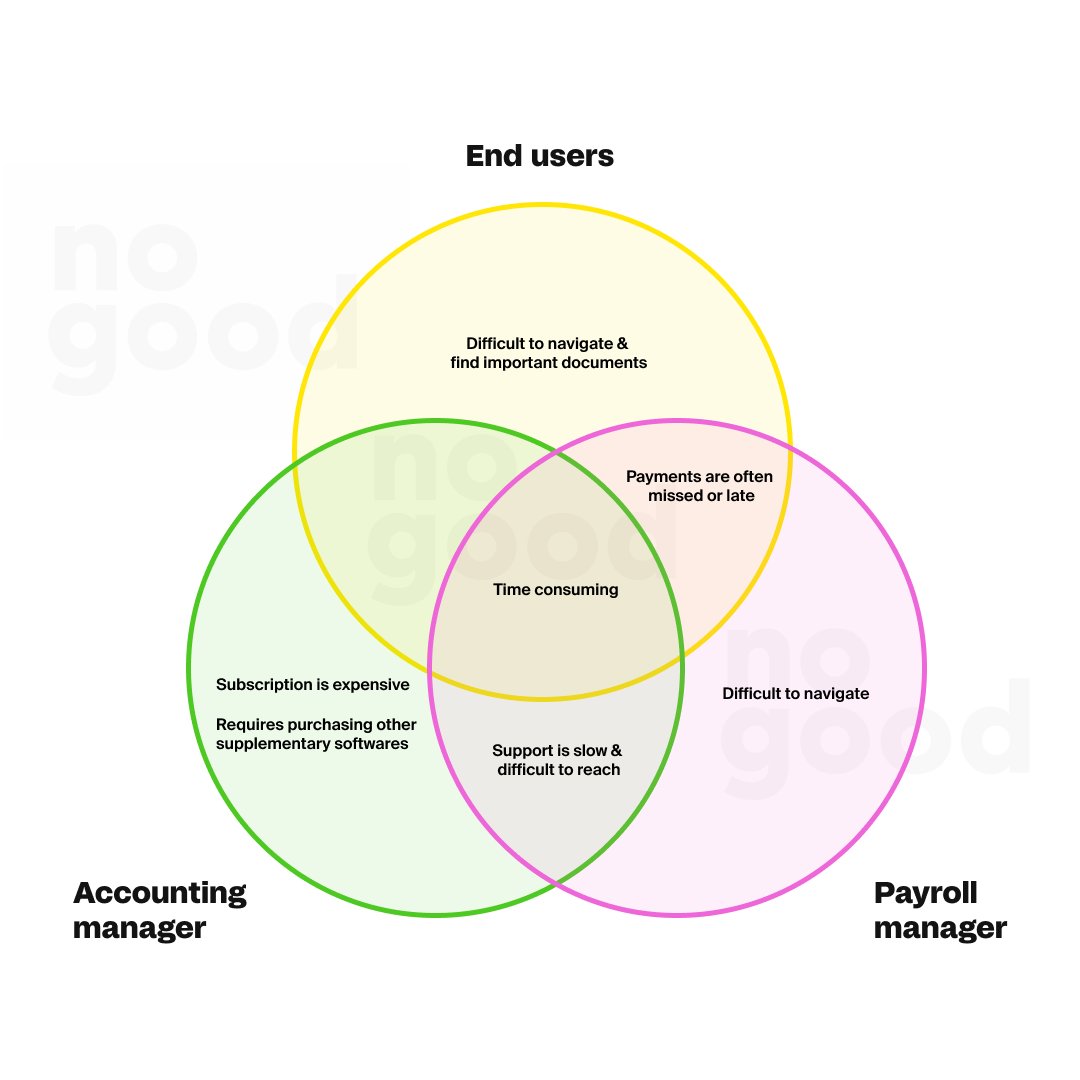
As we can see from the above, there are certain pain points that overlap, but there are also distinct narratives forming for the content offerings that would be a part of our growth strategy as they pertain to each persona. While both end user and payroll manager may respond positively to messaging that is specific to simple & easy payments, their motivations and goals aren’t necessarily the same — and so the messaging would vary as we target them each individually in our communications.
The SaaS User Journeys
Once we’ve determined the pain points and motivations of our different personas within an organization – and by extension our content narratives – we can now determine the appropriate channels for discovery for each of these personas. In these instances, we look at the organization itself as the user being driven down the funnel, with the individual personas acting as the various stages of the funnel in the user journey.
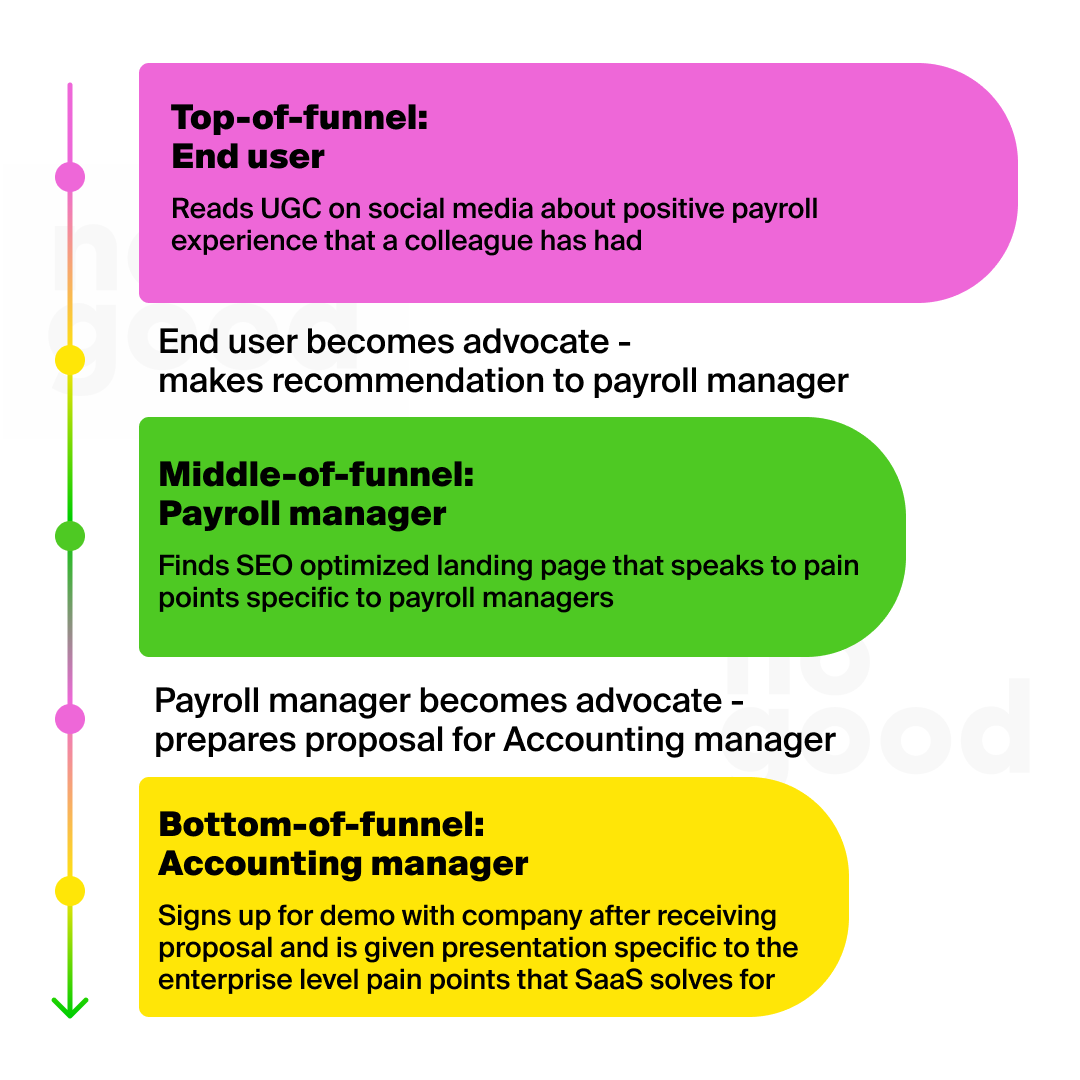
As we’ll explore moving forward, and as we can see here, the user journey is optimized to cater directly to the persona within the organization at each step of the journey, and these steps can – and should be – rearranged and adjusted in a multitude of ways. A truly comprehensive and exhaustive growth strategy will have mechanisms in place to capture users of each persona, at each step of the user journey, in order to ensure that no users are ever lost in their journey and conversions are captured as efficiently as possible.
While the above journey begins with the end user, it could just as easily begin with the accounting manager being targeted with paid media, proposing the solution to the end user, who then advocate to the payroll manager. Ultimately, the focus and goal is to nurture and cater to the user – in this case the organization – from as many conceivable iterations as possible to ensure comprehensive optimizations within the journey.
Developing your B2B SaaS strategy
Now that we understand the various interactions of the user journey for organizations as they pertain to B2B SaaS organizations, we can now better understand the different levers and mechanisms for developing a growth strategy. These tactics, as with most strategies, are typically implemented in chorus with each other in order to create comprehensive frameworks to drive users from discovery to conversion.
Understanding how these mechanisms work will allow you to not only implement these tactics into your B2B SaaS strategy, but do so in a way that is targeted and optimized by understanding which persona you’ll be optimizing them for and where they are in the journey.
SEO
SEO is an incredible mechanism for not only discovery, but for crafting content that specifically addresses pain points for the various personas within an organization at each step of the user journey. Through the development of either specialized landing pages or targeted blog content, you can build content that is not only engineered to answer the questions your users may have, but address their pain points, and do so in a way so that they find your information when actively seeking it out.
While there are some nuances that need to be considered in the development of your content, some SEO best practices that should always be implemented when developing content for search should be followed — here’s a quick checklist for reference:
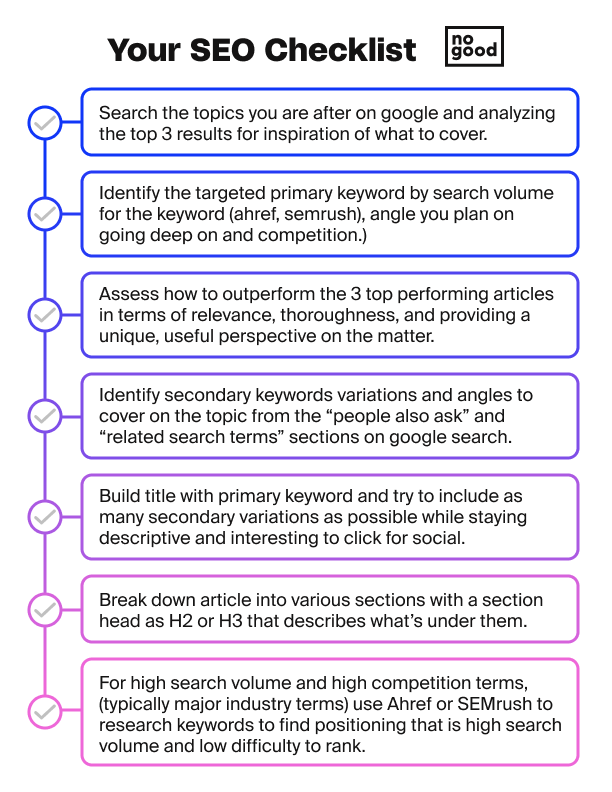
For these strategies, however, optimizing for your audience is going to be the crucial piece in the development of your content. This is because if you’re optimizing content for search, but for the persona and the answers or solutions that they are seeking. Building a landing page for the end user versus the manager versus the decision maker will yield vastly different results and require that the piece itself is engineered in different ways all the way down to the focus keyphrase.
Once again using the payroll system as an example, an end user may search for answers as to why their direct deposit has gotten delayed, leading them to find a landing page for the payroll software company that describes the reliability of their system, as well as other solutions that they provide. While this content may also be relevant to the manager, they may also be searching for solutions to the issues that they’re having with their current system which are causing the delays to their direct deposit payments — creating opportunities for the landing page to address these solutions and the ease of use for payroll managers to use their software. And finally, for the decision makers, the page would be engineered specifically to their needs and interests in order to address cost, scalability and other potential concerns that that persona may have.
Taking these a step further, the landing pages or blog posts can also be engineered to stage in the user journey that the persona is in. If it’s a first touch point, the content can be broader in order to answer more questions to help to drive the user through the journey. The content can then be refined further as part of a broader SEO strategy in order to have specific pages or blog posts that provide more comprehensive information that is specific to each product feature or solution that the service provides.
Content
With content making the meteoric rise in prominence that it has in past years, particularly with the advent of brands as a personality and social advocacy, there has never been as much opportunity for B2B brands to leverage content for growth as there is today. This was mainly due to the fact that targeting through content, specifically on social, was an abstract concept and one that was difficult to execute — if for no other reason than there wasn’t typically a defined set of criteria that professionals fit into.
Again using our payroll SaaS company as our example to build upon, if we were to look at our 3 personas, it would be fairly difficult to determine exactly who those individuals were for targeting through social in the same way that we were able to target them through their pain points and keyphrase inquiries — with the exception of LinkedIn or other career driven platforms. The shift, however, that we’re experiencing is in the development of niches within specific industries, or for specific roles within industries, allowing brands to create content that caters directly to specific roles or functions within an industry, and also to leverage UGC by aligning with those prominent figures within their industries who use their service.
Developing your content mix
In the same way that landing pages and blog content were developed and engineered to cater specifically to our different professional personas, the same can be done with organic content in order to create a content mix. With organic content, however, the main difference is that there are nuances and fluctuations in the content, voice & tone, and delivery that need to be addressed and accounted for for each platform and persona in order to be accommodating to them.
This is where understanding your personas is particularly important, as this understanding will help immensely in the development of your strategy and content mix. If the decision makers are understood to be more active on LinkedIn and engage more in more robust content that is specifically engineered to help them progress their skill set, then the content offering being developed needs to take these specifications into account. Likewise, if the end user is most active on TikTok and responds more directly to UGC or educational content, then the same considerations must be made when developing your content mix in order to meet the personas not only where they are in regard to the social landscape, but as well as in their careers and development journey.
Finding your voice & personality as brand
As the lines between brand and persona begin to blur, and interactions between brand and user become more common, finding and refining your brand voice has become more important than ever in the modern media landscape. Though the concept of having a direct interaction with a payroll software company on Instagram, Twitter, or TikTok may seem as though it would be a foreign experience — the reality is quite the opposite. As brands lean more heavily into the space of content, and engagement becomes one fo the key metrics of success, we are experiencing and witnessing more and more the interaction of B2B brands and end user in the public media space.
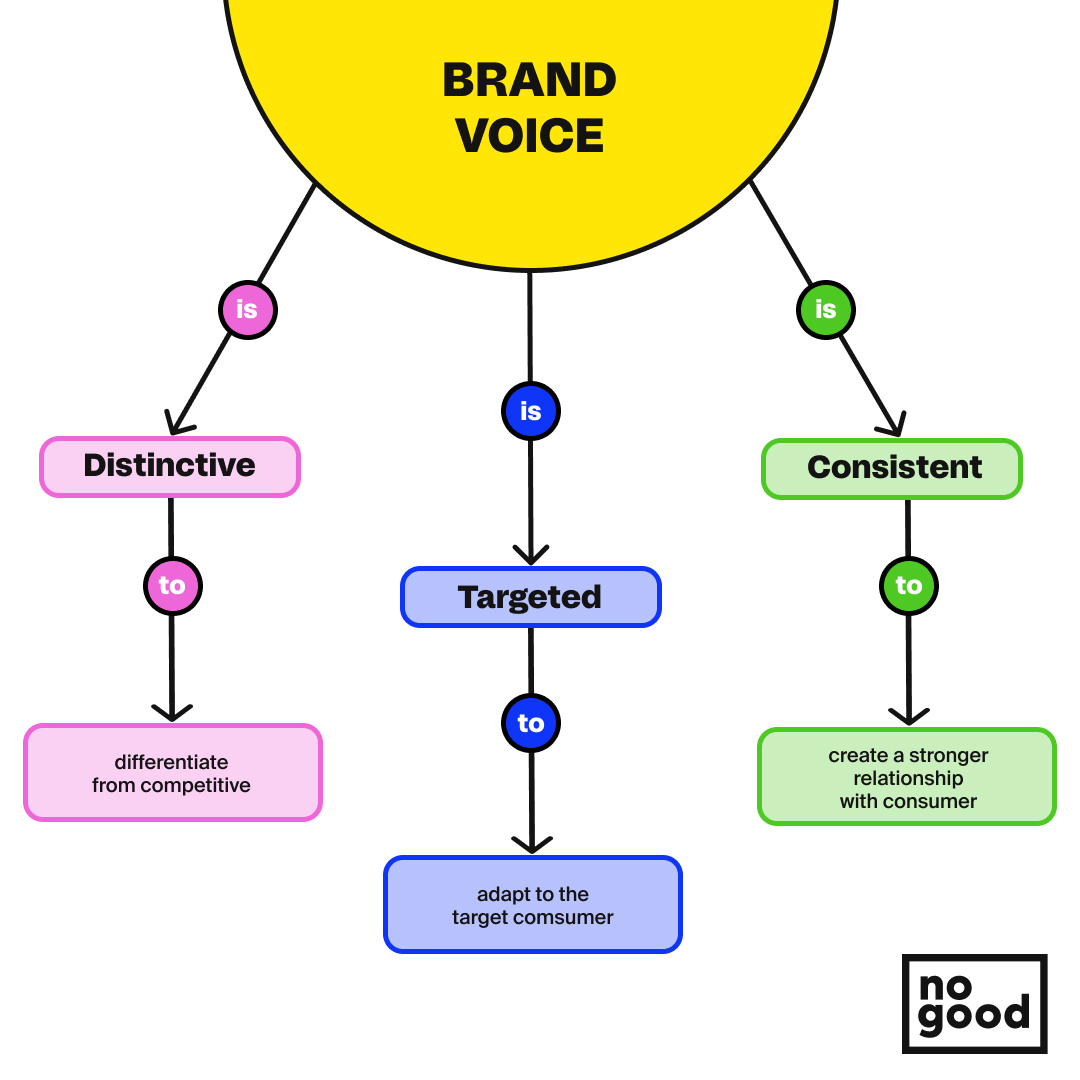
As a byproduct of this shift happening, content mix becomes an easier hurdle to overcome — as it allows broader appeal of content across channels. Though the subject matter of a particular B2B service may be dense, or require a certain level of expertise, by adopting a personality for your brand, or incorporating memes into your content mix, there becomes opportunity to achieve a broad appeal and lessen the lift of refining your discovery strategies.
This is not to say, however, that by adopting personality into your strategy a brand is completely free of having to consider their target audiences & personas — as these content pieces are still necessary for moving users through the journey. It does, however, make it a simpler task to lead a brand from being unknown, to being known.
Previously, while a brand might be known as the payroll service that posts solely about tax documents and payment processing, there now becomes opportunity to be a meme page. The content, by extension, then becomes more universally understandable and appealing, because it presents what would otherwise be dense information in a simple and easy to understand format. The requirement of solving for painpoints, or answering questions, however, does not disappear completely — but shifts to be presented in a more digestable way.
Cold email isn’t dead
If you work for a business, then it’s very likely that your inbox is something of a minefield of cold emails from different services, pitching solutions, and suggesting that you “hop on a quick call” to discuss how you might work together. This is a wonderful example of how NOT to approach email as a mechanism for B2B SaaS growth.
As with any other content, understanding the persona and catering directly to them is the most important aspect of a successful email strategy since trust & advocacy are such large parts of the conversion process. While with SEO & our other content tactics there are considerations made for where in the journey a specific persona is, this information is of the utmost importance for email — as improper targeting can sully trust & throttle advocacy.
Ultimately, the same is true for email as the other levers — in that you should be leading with the solution you’re offering. However, ensuring that you’re reaching the “right person” is key here. For as many emails that are sent as part of a B2B SaaS strategy that begin with “I’m not sure if you’re the right person” just as many are ended with that very same email as they indicate lack of research, lack of understanding of their target audience, and most importantly do not lead with their value proposition.
While it is absolutely true that an improperly targeted email may just get lost in an inbox, there are numerous potential ripple effects that arise as an extension of improper targeting.
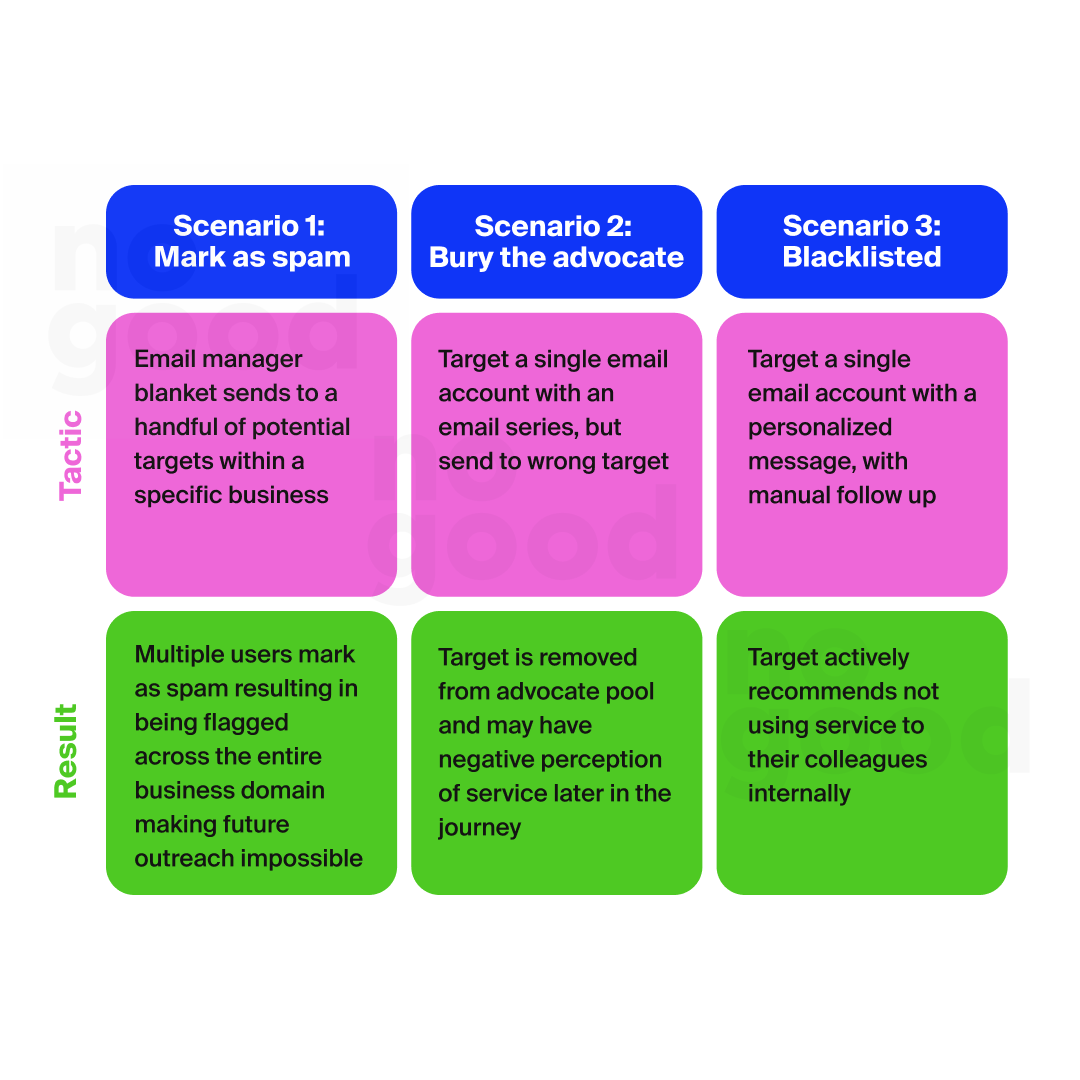
As we can see from the above, mistargeting can be incredibly detrimental to the future engagement within an organization either from organically burying potential for future advocacy, or by having an entire domain blacklisted — preventing future communications from ever being seen.
Email, however, can be an incredibly effective means for growth if leveraged properly & paired with our other growth mechanisms.
For cold emails specifically, there is a slightly higher lift involved in determining who it is that you should be targeting, how & when you should be targeting them, and in what way you should be approaching your messaging to avoid being viewed as “pushy” or “too salesy”. Particularly in the realm of B2B Saas, the most likely target for email is typically the manager, as they will likely be tasked with finding solutions, researching them, and determining efficacy internally prior to moving the process forward to the decision makers. It’s unlikely that the end users will be viable targets, as they will not typically be out seeking solutions, in the same way that the decision makers wouldn’t be — and so are not healthy targets for cold email outreach.
Doing email right
The most effective means of email campaigns, however, is by crafting your messaging around existing intent and the understanding of your audience and where they are coming from through pairing these campaigns with other content.
This can be accomplished by developing campaigns that are tied directly to your various content pieces or landing pages that are triggered once a user has signed up for a form on a particular page, or perform a certain action. This not only removes the possibility of mistargeting the user, but validates that the user is already interested in the service you are providing and that your targeting is in alignment with the persona. By creating these campaigns, we are able to organically move the user through the journey, and do so without the additional lift of a sales person or other representative doing any manual work.
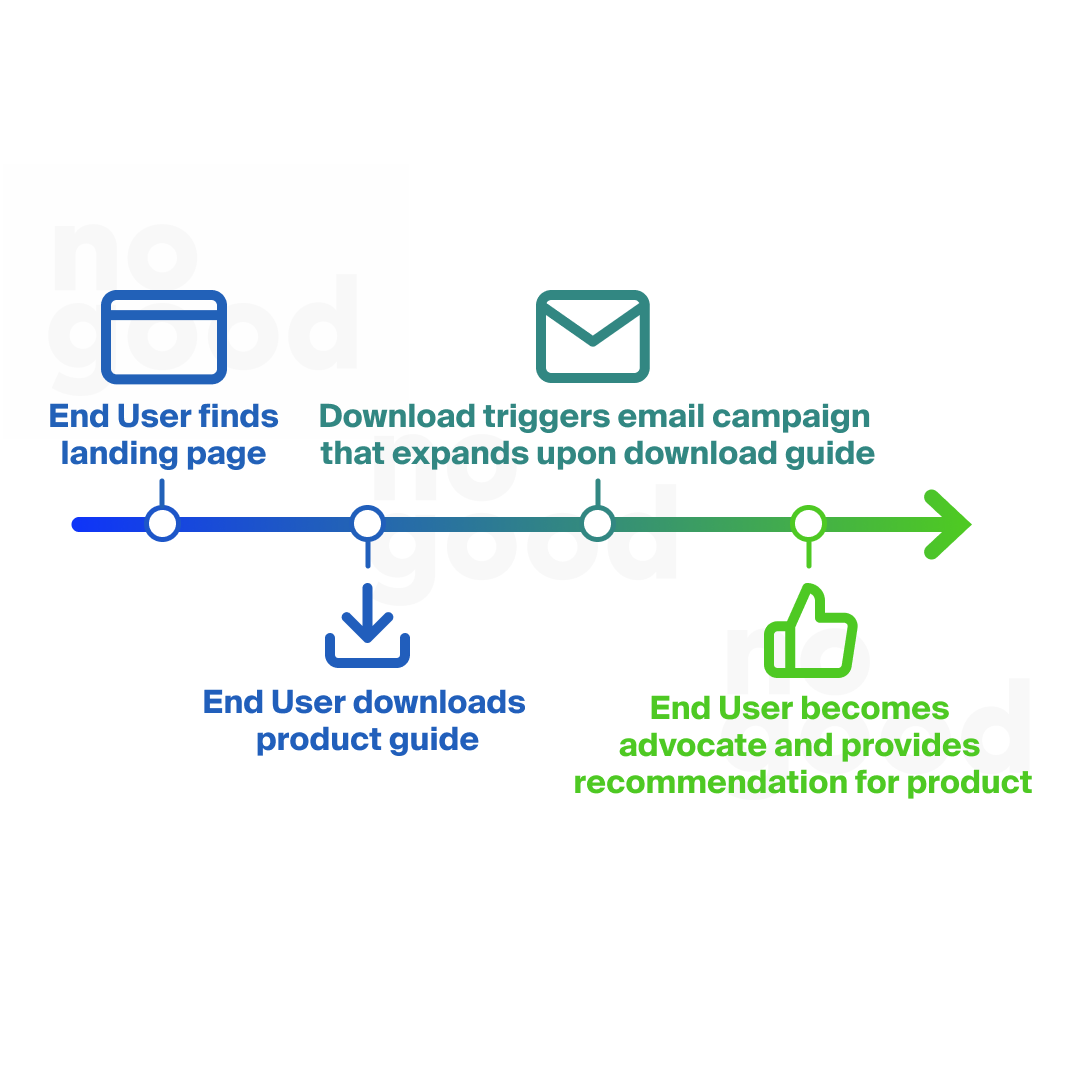
As seen above, our email campaigns can be developed specific to the persona to further address their inquiries, while adding touch points to the user journey. In doing so, we not only position ourselves in a way that keeps the brand & service top of mind, as they will now receive regular updates to help keep the lead warm, but also continue the education and conversion optimization process as the campaign is sent.
Human interactions
While marketing and sales are often seen as two separate entities, the reality is that the two act in tandem and should be optimized and developed in tandem of one another. In the case of B2B SaaS, there is a fairly common practice of not only having a representative provide insights for the managers or decision makers prior to conversion in order to answer questions and help guide them through their journey, but also act as a continuing mechanism for advocacy after conversion.
In the same way that we discussed with email, integrating sales reps into your growth strategy can be an incredibly effective way of controlling the user journey and helping to control narratives and process. This can be done in place of, or addition to, the triggering of an email campaign when actions are taken upon discovery of your landing pages or blog content — either creating a pathway for users to schedule a meeting with a sales rep or trigger an email to a sales rep that prompts their direct outreach once there is confirmed intent from the action taken.
By inserting themselves into the process, sales representatives can perform a similar role to content creators in that they can advocate for the product, and act as a trusted resource in the conversion process. Through direct interaction with the persona, there becomes opportunity to directly answer questions, focus on solutions, and of course push towards a product-led solution that can help users move through the journey.
Ad Channels
Targeting ads for B2B SaaS projects can be a tricky process for the same way that developing a content mix is for such businesses. While CPG or other consumer facing brands may have broad demographics that they can target and then refine over time based on the performance of their ads, B2B SaaS faces the challenge of targeting individuals within organizations who not only hold different roles across different functions at different seniority levels.
There are, however, a few ways to work around these things in order better target audiences and have higher conversions for your project — let’s get into it.
LinkedIn:
If for no other reason than being a social network for professionals, LinkedIn is one of the most efficient platforms for advertising any B2B business — SaaS included. Beyond that, however, the targeting options that are available within LinkedIns ad manager are supremely useful to use as a jumpoff point to begin building & refining your audiences and gaining insights into who your most valuable audiences are, and run some incredibly refined experiments if you really want to.
In addition to locations, LinkedIn allows users to refine their targeting by audience attributes such as company, job experience, education, demographics, interests and traits — though for the purpose of this exercise we’ll focus specifically on company & job experience.
Building an audience:
Starting with company, ad targeting can be refined by category, industry, name, revenue, size, and a number of others if you wanted to drill down really deep; which we will in a bit.
To start though, using the personas of the users within a company that we developed, or the parameters that we’ve set for the companies that would be potential customers of our service, we can already create some fairly stringent criteria to build upon. This criteria can be both speculative, based on predictions and modeling as you prepare to go to market, or quantitative based on existing customer profiles for the businesses that you have already worked with.
Let’s say, for example, that we already have 100 customers, 10 of which we’ve seen move up their subscription tier in the past 6 months and our goal is to find new customers like them. By distilling the specific information about them as to how much they’ve grown during that period, their revenue, industry, etc, we can create a model for targeting similar customers & businesses with our LinkedIn ads.
For a speculative model, we can project certain things based off of the business itself, the function of the service, and a few other pieces of information in order to create the parameters for our ads. If our service costs $50k/month with our lowest tier allowing 100 licenses and being specific to the design industry, that immediately refines our targeting based off of just that information alone since we wouldn’t necessarily be targeting businesses making $1M/year in revenue since it would cost them 60% of their revenue just to pay for the subscription and likely also likely dont have 100 employees for the licenses.
Moving to matched audiences:
The second fold of why LinkedIn targeting is such a gem for B2B SaaS is that it can replicate success as much as it can refine it — particularly through matched audiences. Matched audiences can range from retargeted users to lookalikes based off of uploaded contact lists. And being a professional network, and also a social media platform, there is a fairly organic funnel from lead to organic connection, which provides incredible insights into contact and other information that is not typically available through other marketing & ad platforms (though we’ll get to them in a bit).
So as you syphon off leads into conversions based off of your initial targeting, which you refine as you role out your ad strategy, you generate a highly optimized list that can then be churned back into the LInkedIn ad platform as a matched audience for new ad deployment. These new matched audience targets will then be based off of not just speculative or modeled parameters, but real people who have already not only experienced your ads and product, but have converted — making them an incredibly valuable targeting resource.
Moving on to Meta
It’s a bold move deploying B2B ads out into the wild because, as we’ve discussed, there isn’t often a defined demographic for individual job titles, or industries, or companies. That is – at least – not before you have a highly targeted audience to use for your ads.
While it is true that Facebook & Instagram have over 1B monthly active users combined, which is a massive difference when compared to LinkedIns not-unsubstantial 310M, the reality is that advertising on Meta platforms prior to optimizing your audiences is going to be incredibly wasteful and you’ll likely see unsatisfactory conversion rates.
That said, once you’ve been running your LInkedIn campaigns for some time, have refined your targeting, and built a healthy matched audience, then it’s absolutely fine to begin pushing out ad creative outside of the confines of the professional network that is LinkedIn. Some concessions, however, should be made in the altering of the creative in order to match the platform, and also meet the audiences where they are in their days.
While the focus of the creative shouldn’t necessarily waiver from solving the pain points of the audience, it should be recognized that if you’re meeting them on social media, it’s likely that they’re there to try to escape from work in some way — or at least take a break. By leaning too heavily into the focus on the job aspect of your ad, regardless of your targeting, you run the risk of potentially losing interest from your audience by violating their space and losing them forever.
TikTok & maybe Twitter again someday
Brands, particularly in the B2B space, have been hesitant to rush to TikTok since there is more opportunity for social validation and UGC driven content and conversions on the platform, or running UGC as ads, than there is for straight up ads — and we get it. For the demographics present on TikTok – aging up as they may be – the reality is that the decision makers are likely not there yet, though if they are they are more susceptible to content than ads at this point in the lifecycle.
And while it stands to be seen exactly where Twitter will land, the reality is that most major advertisers, agencies, brands, and advisers, are pulling ad-spend there while things shake out and the dust settles. This may mean an incredibly low CPC for the immediate future, but it’s a shaky ground for brand safety in the current climate — particularly for public facing brands like those in the B2B sector who rely heavily upon professional relationships.
Product as growth
Product, specifically for B2B SaaS brands, is an incredibly effective tool for conversions and growth as it provides users direct experience with the solution that is being offered and does so in a way that doesn’t require additional resources, scheduling or interactions with sales representatives (though it should be an option) or other manner of moving parts. Ultimately, the decision to make any new software decision across an entire organization or team is a substantial one and – as discussed – one that often requires the input and advocacy of each persona in their own capacity. The integration of a new software product to not just workflows, but other current software stacks and skill sets can often make or break decisions for adoption — making product-led growth an incredibly useful tool for growth.
Once again, understanding what and when to make an offer is a crucial detail to build out as you develop your strategy — knowing which persona to target and make the offer to, and at what point in the user journey to make it.
Making an offer to the wrong person, at the wrong stage of the journey can turn users off to a product if they find themselves lost or unfamiliar with what it is a product is offering upon receiving an offer, while sending an offer to the wrong persona can equally disrupt the journey by leading to a dead-end in the decision making process if they’re not properly equipped to move the process forward.
While there is something to be said about users having the freedom to poke around and get a feel for a product before getting too deep into a journey, it is also incredibly important to nurture the user on their journey and build them to the point where it makes sense to begin testing and seeing if the product suits their needs.
This is the groundwork that we’ve previously discussed through content, SEO, email and sales — a foundation building practice that is used to build and educate the personas as they continue on their journey.
If properly optimized and leveraged, by the time the user reaches a sales person or product offer, they will have likely already removed most barriers to conversion across teams, budget, and otherwise. This just leaves testing and training as the last remaining barrier to overcome.
Product offers for B2B SaaS are equal parts collaboration with the sales team, organic communities, and testing on the side of the users — allowing a balance between experience the product in a hands on environment, while having access to the representatives or community in order answer questions and overcome obstacles.
This part of the process serves multiple purposes for the users in validating their decisions to convert by allowing real time implementation of the product, ensuring that it acts as it’s supposed to, that it justifies the cost that’s being asked, and of course integrates with current workflows — or at least doesn’t require unreasonable learning curves for adjusted workflows.
Assuming all goes well during the product offering, the journey is finally complete once the offer ends and the subscription is renewed as the user has seen the value, has been properly educated in the service being provided, and has validated these things across all the personas necessary to make the final decision for adoption.
The post-adoption journey
While this may be the end of the adoption process, the journey and relationship have a nuanced future where the B2B SaaS brand and end user continue their relationship in order to nurture growth as new product features are offered, the end user grows & potentially expands their membership, and advocacy is encouraged on behalf of the end user.
This helps not only feed back users into the loop to help continue growth as both brands grow & expand, but to help create feedback opportunities to optimize the existing growth strategy based on the insights provided by the end user.
These tools are all you’ll need to build your B2B growth strategy, though if you ever feel as though you need a partner, we’re always available to lend some assistance.



